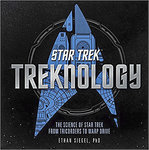

When Star Trek first premiered 51 years ago, the world was in the midst of the Cold War while violence from race riots and scenes from the Vietnam War were on the evening news every night. To some, it seemed humanity would not survive.
However, once a week on NBC, thousands of people would tune it to watch stories from a future where humanity survives and thrives in the 24th century.
“Star Trek was always a positive image of the future where people use technology to better humanity,” Toledo resident Ethan Siegel said.
Siegel, who earned a doctorate in theoretical astrophysics from the University of Florida, recently released his latest book, “Treknology: The Science of Star Trek from Tricorders to Warp Drive.” In it, he examines the technology of the series and humanity’s progress in developing it.
“I was taking a look back at what we thought the future would be in the 1960s,” he said at a book signing event on Thursday at the Art Gallery 505 in Toledo.
Many technologies have been developed and integrated into everyday life so smoothly that many didn’t even notice, Siegel said. For example, automatic sliding doors, voice-activated computers and tablets all made their first appearances in entertainment before becoming realities.
Other technologies prominent in Star Trek are in development with working prototypes, such as the medical diagnostic device called a tricorder or the energy-based weapon called the phaser.
In the show, a tricorder can diagnose diseases and injuries and give details about a patient’s condition in seconds. Other versions of the device are used for scientific research, details about the environment and navigation. The phaser is an energy weapon with adjustable settings that in the television show, is capable of stunning a person or knocking them unconscious without causing them any permanent harm.
At our current point in history, Siegel believes the technology that will help humanity the most is the phaser because it could prevent a number of shooting deaths. With it, law enforcement officials would be able to subdue a violent suspect from a safe distance without permanently harming the suspect.
“Ironically, it may be a weapon that helps us achieve peace,” Siegel said.
Medical advances such as curing blindness or providing cybernetic limbs or implants are technologies that will appear in the next 30 years or so, he added.
Some technologies from the show are not as close to being invented; however, the first steps are being developed. For example, on the show a device called a replicator can rearrange matter to create food, clothing and almost anything. Although that technology currently does not exist, 3D printers are similar, Siegel said.
Other technologies are theoretically possible, but humanity is far from achieving them. Warp drive, the faster than light travel used on the show, is among those technologies, Siegel said.
On Star Trek, warp fields shorten the distance between two points in front of the starship with the distance remaining the same behind the starship. This allows that distance to be traversed in a shorter time period. So instead of taking 40 years to travel between two stars, it would take one, Siegel said as an example. In addition, the time that has passed on Earth will remain the same as the time passed on the ship.
In Star Trek, when humanity discovers warp drive, they make first contact with another species called the Vulcans. This happens after Earth is decimated by World War III, when humanity caused the most harm to itself.
After making contact, humanity realizes how small it is compared to the cosmos and unites as a single world instead of several different nations. This leads to technological advancements that end poverty, famine and many medical conditions.
In the show, humans better themselves and the world around them through technology, Siegel said.
Although humans may not follow the same path as the humans in the fictional world of Star Trek, they can still better themselves and solve many social and economic issues through technology, he said.
“Treknology” by Ethan Siegel is available online through sellers such as Amazon.